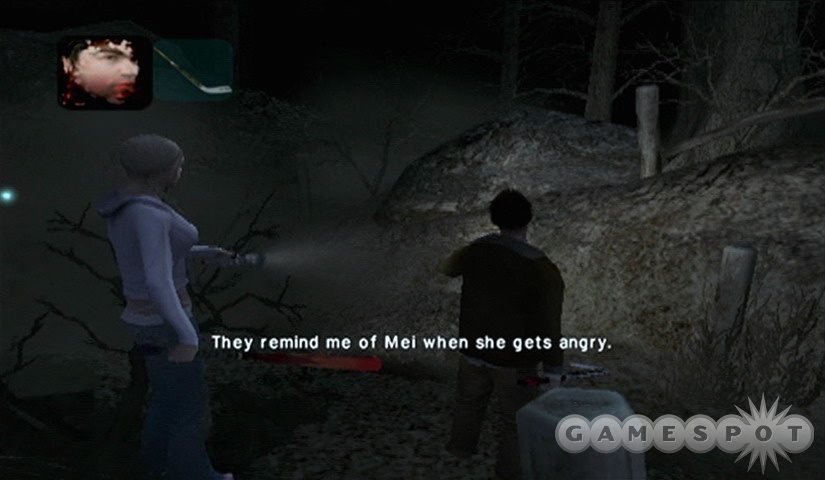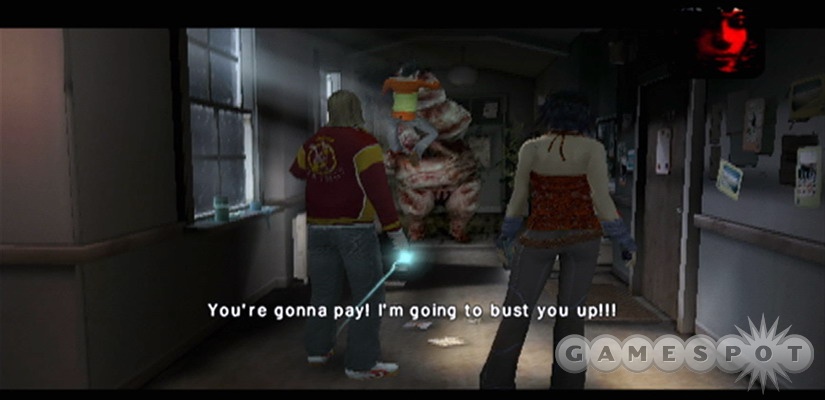In Obscure: The Aftermath, young college students take on demonic monsters while their friends and fraternity fellows get ripped into bloody shreds. Most reasonable people would react with shock or fear, yet this horror adventure game's characters are more interested in clinging to outdated stereotypes. Corey Wilde, for example, isn't concerned about the giant ogres bursting with bulbous tumors that have infiltrated Fallcreek University. Rather, his beloved car's been totaled, and someone must pay. And so it goes with Corey and his chums, who approach the campus's mutant infestation with the same degree of intensity that they would a study session.

It's easy to assume that developer Hydravision was trying to deliver a Scream-like parody of teen slasher films. Perhaps that's so, but the tongue-in-cheek irony necessary for such an endeavor is missing, instead replaced with bad sexual innuendo and humorless one-liners. From bad dialogue ("I've seen all of Corey's x-rays; I know him inside out") to third-rate voice acting, every character is stripped down to a cliche. At least the characters provide something tangible to grasp because the plot is paper thin, though it does offer some veiled commentary on the perils of drugs and sexual debauchery. What the plot lacks are the most important elements of a good survival horror game: scares and suspense. If the main characters can't bother to feel the occasional chill, there's no reason why we should ever get goose bumps of our own.
Nevertheless, there are some atmospheric touches, though many of them are undermined by the general lack of tension. Some scenes are viewed through a grainy black and white filter, an effect that has been used in games countless times but is still utilized with some success in Aftermath. The darkest environments, such as a murky forest, are the most fitting partially because they offer much-needed atmosphere and partially because clearer lighting reveals that Aftermath does not live up to the visual standards of its platform. Character models are stiff and lifeless, textures are rendered in low resolution, and cutscenes are pixelated (though some of them reveal some nice cinematic flourishes). Some areas look properly dingy and degraded, but the game doesn't have a cohesive artistic vision, so elements like these feel practically accidental. The main saving grace is Olivier Deriviere's moody soundtrack, which features some nice string tracks and interesting vocal stylizations.
As in 2005's Obscure, in The Aftermath you'll take control of one student at any given time, though another AI-controlled teammate will tag along. The game's hook is that each character has a given strength and that you will need to alternate between the two of them or use them together to solve various puzzles. For instance, Mei can hack into security devices using her PDA, while Kenny is strong enough to push around heavy objects. Other times, they'll combine forces, such as when Corey pulls Amy onto a fire escape. There are a few interesting puzzles that result from this arrangement, such as one where you shine a spotlight onto your light-fearing foes using one character while the other bashes away at the baddies. Yet for the most part, these tasks are relatively straightforward and unspectacular. To spice things up, you can beg a friend to grab a Wii Remote and join you, at which point he or she will take control of the second character. This might be a refreshing improvement over the game's mediocre AI, but it doesn't make the experience any more engaging.
Aside from the cooperative element, Aftermath is simply an amalgam of Resident Evil and Silent Hill gameplay mechanics, though it does have its bright moments. For example, in one clever mission, you guide one character through a series of hallways from the viewpoint of another, who must keep the security cameras in focus for you to see the action. It's a neat idea, and there are others like it, but most of them are compromised by the terrible implementation of the most basic elements. The most egregious offender is the camera, which can be controlled somewhat using the Wii Remote, though you don't have full control most of the time. This is maddening enough when you're walking through hospital corridors and can't rotate the camera so that it's behind your character's back, but when combat is added to the mix, the game falls apart in the most fundamental ways.
A typical battle scenario may have you taking on several enemies at once, either with a melee weapon or with a firearm. Either way you go, you need to hold the Z button on the Nunchuk to enter combat stance. In the case of a blunt instrument, you simply swing the Wii Remote to swing your weapon, which isn't such a bad mechanic on its own. However, because the levels are so confined and the camera is so difficult to position, you may not be able to see your attacker. This is a big deal because like other games in the genre, Aftermath doesn't keep you well stocked with health packs, though you take quite a bit of damage in most encounters. Because you have so little control of your view, this leads to deaths that are essentially out of your hands. And once you equip a ranged weapon, the game reaches even higher levels of absurdity.

With a gun in your hands, you'll still need to press Z to prepare for combat. This time, you'll hold A to target your enemy and pull the B button to fire. It's a bit muddled, but it's an understandably deliberate element that is consistent with the genre. However, the implementation is all but broken. If an enemy isn't onscreen, you can't target it, and it's very common for the monster to appear between the player view and the onscreen character. The creature can attack, but you can't fire back because you can't move the camera to a workable position. Additionally, entering combat stance may force the character to point his or her weapon away from the camera--which, in this case, is away from the enemy. The targeting is also close to broken. Pressing A may or may not lock on to an enemy, and once you are locked on, the camera may go into convulsions, making it difficult to tell what's going on. Again, this is an unforgiveable gaffe in a challenging game that requires you to be frugal with ammunition and health packs.
If you liked the first game in the series, you'll find plenty of crossover elements, but then again, if you played the original Obscure, you already have an idea of what to expect. There's nothing wrong with exploiting a proven formula, assuming it's done well. Unfortunately, In Obscure: The Aftermath, nothing is done very well.